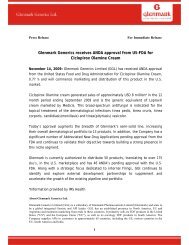Download - Glenmark
Download - Glenmark
Download - Glenmark
You also want an ePaper? Increase the reach of your titles
YUMPU automatically turns print PDFs into web optimized ePapers that Google loves.
Schedules annexed to and forming part of the Financial Statements<br />
(All amounts in millions of Indian Rupees, unless otherwise stated)<br />
SCHEDULE 21 - NOTES TO THE FINANCIAL STATEMENTS<br />
1. SIGNIFICANT ACCOUNTING POLICIES<br />
i) Basis of Accounting<br />
The Financial Statements are prepared to comply in all material aspects with the accounting principles<br />
generally accepted in India, including the applicable Accounting Standards notified under section 211(3C) of the<br />
Companies Act,1956 and the relevant provisions of the Companies Act,1956.<br />
ii) Fixed Assets (including Intangibles), Depreciation and Amortisation<br />
Fixed assets are stated at cost less accumulated depreciation and amortisation. The Company capitalises all<br />
costs relating to the acquisition and installation of fixed assets. Expenditure directly related to the setting up of<br />
new projects, is capitalised as an indirect cost towards construction of the fixed assets.<br />
Depreciation is provided using the straight line method, pro-rata to the period of use of assets, based on the<br />
useful lives of fixed assets as estimated by management, or at the rates specified in Schedule XIV of the<br />
Companies Act, 1956, whichever is higher. Brands/Intellectual property rights are amortised from the month of<br />
products launch/commercial production, over the estimated economic life not exceeding 10 years.<br />
Fixed assets having aggregate cost of ` 5,000 or less are depreciated fully in the year of acquisition.<br />
The Company has estimated the useful life of its assets as follows:<br />
Category<br />
Estimated useful life (in years)<br />
Factory and Other Building 30 - 55<br />
Plant and Machinery 8 - 20<br />
Vehicles 5 - 6<br />
Equipments and Air conditioners 4 - 20<br />
Furniture and Fixtures 10<br />
Computer Software 5<br />
Brands 5 - 10<br />
Leasehold land and improvement is amortised over the period of lease.<br />
iii) Borrowing Costs<br />
Borrowing costs that are attributable to the acquisition and construction of a qualifying asset are capitalised as a<br />
part of the cost of the asset. Other borrowing costs are recognised as an expense in the year in which they are<br />
incurred.<br />
iv) Impairment of Assets<br />
The Company assesses at each Balance Sheet date whether there is any indication that an asset may be<br />
impaired. If any such indication exist, the Company estimates the recoverable amount of the asset. If such<br />
recoverable amount of the asset or the recoverable amount of the cash generating unit to which the asset<br />
belongs is less than its carrying amount, the carrying amount is reduced to its recoverable amount. The reduction<br />
is treated as an impairment loss and is recognised in the Profit and Loss Account. If, at the Balance Sheet date,<br />
there is an indication that if a previously assessed impairment loss no longer exist, the recoverable amount is<br />
reassessed and the asset is reflected at the recoverable amount.<br />
v) Foreign Currency Transactions<br />
a) Foreign currency transactions are recorded at the exchange rates prevailing on the date of such<br />
transactions. Monetary assets and liabilities as at the Balance Sheet date are translated at the rates<br />
of exchange prevailing at the date of the Balance Sheet. Gain/Loss arising on account of differences in<br />
foreign exchange rates on settlement/translation of monetary assets and liabilities are recognised in the<br />
Profit and Loss Account, unless they are considered as an adjustment to borrowing costs.<br />
b) Gain/Loss on account of foreign exchange fluctuation in respect of liabilities in foreign currencies specific<br />
to acquisition of fixed assets are recognised in the Profit and Loss Account.<br />
vi) Investments<br />
Long-term investments are stated at cost. Provision, where necessary, is made to recognise a decline, other<br />
than temporary, in the value of the investments.<br />
vii) Inventories<br />
Inventories of finished goods, consumable store and spares are valued at cost or net realisable value, whichever is<br />
lower. Cost of raw materials and packing materials is ascertained on a weighted average cost basis. Cost of work-inprocess<br />
and finished goods include the cost of materials consumed, labour and manufacturing overheads. Excise<br />
and customs duty accrued on production or import of goods, as applicable, is included in the valuation of inventories.<br />
Net realisable value is the estimated selling price in the ordinary course of business, less the estimated costs of<br />
completion and selling expenses.<br />
The Company considers several factors in determining the allowance for slow moving, obsolete and other<br />
non-saleable inventory including estimated shelf life, planned product discontinuances, price changes, ageing<br />
Annual Report 2010-2011 63



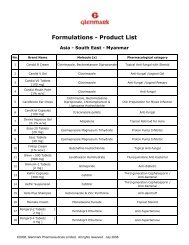


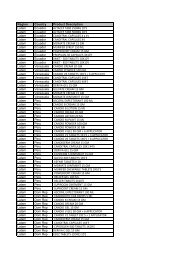
![Formulations [India] â Product List - Glenmark](https://img.yumpu.com/46601329/1/190x245/formulations-india-a-product-list-glenmark.jpg?quality=85)
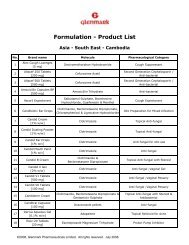
![Formulation [India] â Product List - Glenmark](https://img.yumpu.com/44013338/1/190x245/formulation-india-a-product-list-glenmark.jpg?quality=85)


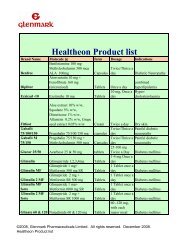
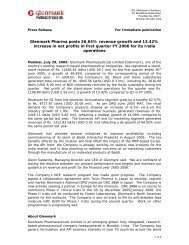
![Formulations [India] â Product List - Glenmark](https://img.yumpu.com/35994839/1/190x245/formulations-india-a-product-list-glenmark.jpg?quality=85)
